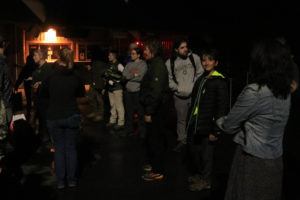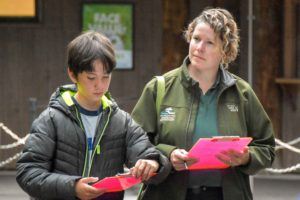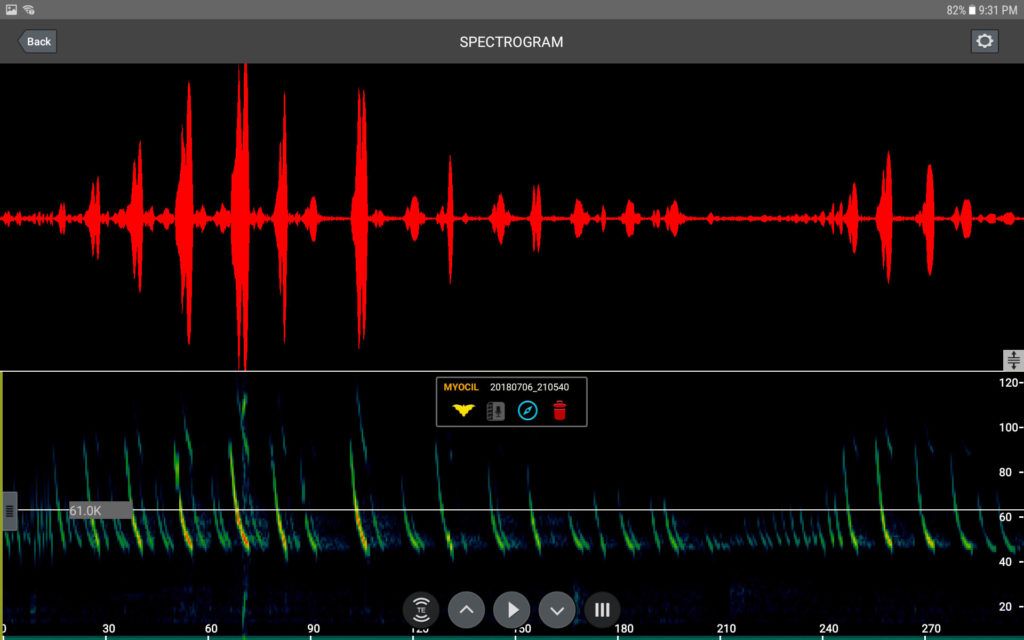The mission began at sunset.
After a quick briefing to receive assignments and equipment, 26 staff and volunteers spread silently out to their locations. In the entrance breezeway, near the tram garage and underneath trees, they hunkered low on the ground as darkness grew. They waited, breath hushed. And then, with a chattering and creaking overhead, the mission began: The Great Trek Bat Count of 2018.

As bats began to fly out from their roosts into the night to hunt, the humans sitting quietly below them began to click their counters, one for each outgoing bat. One staff member had a bat detector device, another a night-vision scope. Data was recorded. Finally, as the darkness became complete and the last bat flew out, the mission was over – at least, for now.
It sounds like a scene from a 1980s superhero movie, but what was happening on June 29 and July 6 around Northwest Trek was actually important science – counting bats, along with other sites around Washington. The goal? To give biologists at the Washington Department of Fish and Wildlife (WDFW) a greater understanding of these little-known mammals – and the challenges they may face to survive.
Na-na-na-na-na-na-na-na…
But, of course, it was also a great opportunity for superhero jokes.
“It was a fun night!” says Zachary Hawn, a staff member at Trek’s sister zoo Point Defiance Zoo & Aquarium who came both nights to count bats and operate the Bat Detector (more on that later). “The technology is really cool. And yes, I definitely heard some people singing the Batman theme song. These animals get a bad rap, and to help and watch them is rewarding.”
Plus, points out Hawn, the experience of hearing and seeing close to 200 bats emerge over your head at night is “an awesome sensory experience.”
“First you hear the chattering, then the whole roof starts to creak, like something much larger is inside,” he says. “It’s like the whole roof is coming alive.”
The Power of One Bat

Northwest Trek zookeeper Wendi Mello and her 12-year-old son had a slightly different – but still rewarding – experience.
“We talked about it all the way up here, and we crept out to our site and lay down on our sleeping pads to get a good angle against the sky,” says Mello. “We saw one little bat flutter out – that was amazing. Then we lay there, and lay there. It started to rain, pretty heavily. We kept watch for 45 minutes, and saw just one bat! But that one bat was worth it. Bats are so mysterious, and to have a window into their lives is amazing.”
Why Count Bats?
So why is Northwest Trek counting bats, anyway?
“The WDFW came to us asking for help,” explains Karen Povey, conservation engagement manager for Northwest Trek. “Our colony is unique because it’s so large – one of the biggest in the region. We’re also unique because we have biologists on staff here to lead monitoring. We can help the department track the status of bats in Washington, so they know more about them. And the presence of white-nose syndrome here really ramps up the critical nature of that knowledge.”
White-nose syndrome is a disease that has spread quickly in eastern North America over the last decade, killing over six million bats and wiping out entire colonies. A fungus that grows on the noses, wings and ears of bats during winter hibernation, it gets its name from the white, fuzzy appearance it may give the suffering animals. Invading deep skin tissues, it irritates the bats as they hibernate, waking them so they burn through the fat reserves they need to survive.
Now it’s here in Western Washington: The first diseased bat was found by hikers near North Bend in March 2016. Getting a better knowledge of bat populations – their numbers, locations, species and behavior – is crucial to understanding the disease, and helping to stop its spread here in the West. Northwest Trek’s research will help protect bat populations.
But it takes a lot of people to count that many bats. Armed with clickers (and aided in dark places by red lights that wouldn’t disturb that bats), each person at the count clicked once for every bat they saw emerging from the roost. Then conservation engagement coordinator Rachael Mueller averaged out the counts. An average of 852 bats were counted on the first night; 613 on the second. Hawn alone, stationed at the entrance breezeway, counted 173 bats in 20 minutes alone.
“Our colony is definitely larger than anticipated!” said Mueller.
The Bat App
For the rest of the time, though, Hawn was operating another device that lent the bat count an air of superhero nerdiness: a bat detecting Echometer, aka a microphone connected to a tablet app. The microphone records the high frequency sounds bats make to echolocate their food (far above what humans can hear, although we do hear their vocal chattering). Then the app, made by Wildlife Acoustics, analyzes the sounds to identify each bat species. Among the species heard at the Bat Count: little brown myotis, silver-haired and Western small-footed myotis bats.

Unsung Heroes
For Povey, the survey – which will happen again next summer – raised some interesting scientific questions that could be answered by ongoing counts: Are species co-mingling? Do bats show fidelity to specific roosts or do they roam? Are they increasing in number? It’s all-important knowledge about a creature that is crucial to humans.
“Bats are really under the radar, but they’re so essential to the ecology here,” says Povey. “They’re the unsung hero: we really need them for pollination and also insect control.”
Adds Mello: “The more knowledge we have, the better we can help them.”
But Povey also sees a closer connection to Northwest Trek itself.
“We have these wild animals that have chosen to live here,” Povey says. “How cool is it that we can care for our own animals and be stewards of these wild animals too? Bats are not universally loved, so it’s great that we can be their champions.”
How You Can Help
- Report groups of bats you see to WDFW. This information will help them understand bat populations and monitor white-nose syndrome in Washington.
- Do not handle live bats. If you find a sick or dead bat, please report it to WDFW using their online reporting form.
- Avoid entering areas where bats may be living to limit the potential of transmitting the fungus that causes the disease and disturbing vulnerable bats.
- Get involved in bat conservation! Help improve bat habitats by reducing lighting around your home, minimize tree clearing, and protect streams and wetlands.
- Try to incorporate one or more snags into your landscape keeping old and damaged trees when possible. Snags provide important habitat for bats and other backyard wildlife.
- For more information on living with bats, and instructions on how to build a bat house, visit https://wdfw.wa.gov/living/bats.html.
-Rosemary Ponnekanti, Northwest Trek